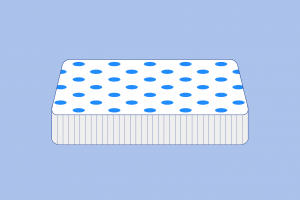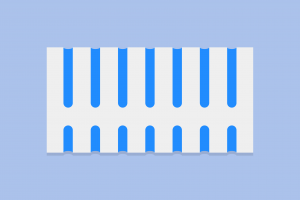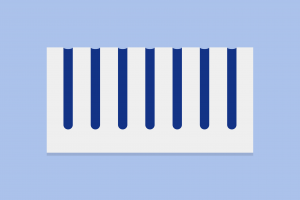Key Takeaways
- Latex Mattress Material: When choosing a mattress, the material it’s made from is a crucial decision. Latex is a popular mattress material due to its comfort and eco-friendliness. It is derived from the sap of rubber trees, making it a renewable and natural choice.
- Talalay vs. Dunlop: Latex mattresses are categorized into two types based on their production processes. Talalay latex is lighter, more responsive, and breathable, while Dunlop latex is denser, less bouncy, and more stable. The choice of material depends on your preferences for feel, price, and eco-friendliness.
- Considerations for Latex Choice: When selecting a latex mattress, factors like firmness, price, cooling properties, and environmental impact should be considered. Dunlop latex is often preferred for its sustainability, lower cost, and durability, while Talalay latex offers a softer feel and breathability.
Which mattress material to invest in is one of the most significant decisions you’ll make when purchasing a mattress. You could, for example, select a bed made of foam, steel coils, or a combination of the two. Latex is another popular mattress material that has grown in popularity since it is both comfy and environmentally beneficial.
Latex mattresses are classified into Talalay latex and a Dunlop latex foam mattress. These two words allude to distinct latex production procedures that might affect the overall feel and performance of the bedding.
The issue is, which sort of latex mattress is ideal for your sleeping habits? Once you’ve determined that, read our articles on the best latex and organic mattresses for more information.
What Is Latex Foam?
 Many people associate latex with natural foam, which is made from a creamy substance made by the hevea-Brasiliensis rubber tree. This is extracted from the tree using a method similar to tapping a maple tree. The sap is foamed to create a slew of tiny gas bubbles, making it a soft and bouncy texture material that latex foam is famous for.
Many people associate latex with natural foam, which is made from a creamy substance made by the hevea-Brasiliensis rubber tree. This is extracted from the tree using a method similar to tapping a maple tree. The sap is foamed to create a slew of tiny gas bubbles, making it a soft and bouncy texture material that latex foam is famous for.
Or in other words, natural latex foam is made from tree sap. The eco-friendly nature of latex foam is one of its main selling points. Latex foam from a rubber tree is a reasonably renewable product that can be up to 100% natural, free of any synthetic materials.
Because natural latex mattresses are free of chemicals, they are often marketed as a greener alternative to polyurethane foam since the two materials have their similarities. For an in-depth comparison of the two, we recommend our latex vs. memory foam guide.
Latex foam is generally soft and cushioned. The foam is also long-lasting, establishing a highly durable mattress that balances a comfortable feel with a reasonable price, and a sustainable production process, and a long-lasting product.
How Is Latex Created?
As we mentioned, latex is made with rubber tree sap. But just how do we get from liquid sap to solid and contouring foam?
The manufacturing process for all types of organic latex mattresses is the same. After the sap from a rubber tree is extracted, a little bit of water is added. In order to convert liquid latex extract into a solid, other ingredients such as gelling, foaming and vulcanizing agents must be added. Typically, these are natural soaps and sulfur.
The liquid latex is then poured into a mold, where the distinctions between Dunlop and Talalay latex become clear.
Talalay Latex
 The Talalay technique, the younger of the two latex refining procedures, is more complicated and more energy-consuming due to additional stages of preparation. However, it provides a cooler, less thick mattress than the more established Dunlop organic latex foam mattress process.
The Talalay technique, the younger of the two latex refining procedures, is more complicated and more energy-consuming due to additional stages of preparation. However, it provides a cooler, less thick mattress than the more established Dunlop organic latex foam mattress process.
Generally speaking, Talalay latex is more expensive than Dunlop latex foam. Some also find it feels “softer” due to its quick ease at contouring to the body.
Process
To produce Talalay latex, makers first whip up the liquid latex into a foam mix inside of a centrifuge before pouring it into a mold, which is only partially filled at first.
The foam and mold are then vacuum-sealed, then permitting the latex to set inside the mold in the same way as bread dough does. When the latex has expanded to fill the mold, it is flash-frozen, a technique that injects foam with a carbon dioxide gas to lower its density relative to the Dunlop process. After that, the latex is baked in while it is frozen, cleaned, dried, and packaged for shipment.
The Talalay process is much lighter and less thick than the Dunlop latex foam mattress, which makes it much more sensitive or “springy.” Because it is less thick, Talalay latex is also more breathable, which means it will enable your body’s heat to escape as you sleep.
Price
Talalay is usually the more expensive of these two alternatives, although the price difference isn’t significant. By stacking the two together, producers may minimize the cost of a Talalay mattress.
Your mattress might feature a denser Dunlop support layer and a springier Talalay comfort layer. This can assist in reducing the overall cost of your mattress while also providing a thicker foundation for your mattress topper.
Advantages and Disadvantages
Talalay’s remarkable springiness is one of its outstanding qualities. If you like a bed that is responsive and adapts to your body’s contours and bounces back, Talalay latex is definitely for you. If you sleep overheated, the increased air circulation in Talalay will likely keep you cool.
If you prefer a denser mattress that holds its shape better, the springiness of Talalay may be a detriment to you. Other disadvantages of Talalay include its increased price, inefficient production method, and decreased durability.
Dunlop Latex
 The Dunlop process has been used for more than a century. It is typically the less expensive and the more energy-efficient of the processes, lacking a few steps of the Talalay process.
The Dunlop process has been used for more than a century. It is typically the less expensive and the more energy-efficient of the processes, lacking a few steps of the Talalay process.
The Dunlop process also results in a denser, less sensitive mattress that is more motion-isolating and stable. Dunlop latex foam is a sturdy material known to resist impressions and sagging.
Process
Like Talalay, Dunlop latex is made by whipping liquid from sap into a foam and pouring it into a mold. Talalay latex differs as there is no vacuum sealing or flash freezing. The mold is placed inside a vulcanization process oven to bake and solidify.
When the latex in the mold has reached the proper hardness, the Dunlop foam is washed to eliminate contaminants and remaining processing mattress materials and end the vulcanization. After cleaning, the foam is heat-dried and ready for delivery.
Feel
The Dunlop latex manufacturing process produces heavier, denser, and much more durable latex than the Talalay process. Dunlop latex is less bouncy than Talalay latex and does not conform as easily. The Dunlop process may be stiffer on the bottom than the top due to natural material in raw latex settling to the bottom of the mattress during vulcanization.
Price
Dunlop latex will be less expensive since it is a more straightforward and energy-efficient process. Remember that the price will most likely not be much lower than the Talalay. Still, because Dunlop is more sturdy than a Talalay, a Dunlop mattress will likely save you a lot more money in the end by not needing replacement as frequently, even with a slim mattress thickness.
Advantages and Disadvantages
Natural Dunlop-made latex is more dense than Talalay, so it will withstand more wear and will not break down as quickly. Dunlop is also less expensive than its competitor. It’s also better for the environment because the process uses less energy and resources.
However, Dunlop latex is typically more dense than Talalay, so if you’re looking for a more responsive mattress, Dunlop latex is not the choice for you. This latex will not bounce back as well as Talalay and will have a different squishy feel.
Our Latex Mattress
Quick Guide: A 30-Second Summary
| Best Latex Mattress | Amerisleep Organica |
-
Price Range
$1049 to $2348
-
Mattress Type
Latex Hybrid
-
Firmness
5 to 6 out of 10 (Medium)
-
Availability
All sizes
-
Warranty
20 Years
-
Thickness
13 Inches
Relying on two latex layers for comfort and supported by hundreds of pocketed coils, the Amerisleep Organica is excellent for anyone seeking a mattress without memory foam.
- Organic cotton and organic wool top
- Comfort and transition layers of latex
- Wrapped coils isolate motion
- Hot sleepers
- Side, back, and combination sleepers
- Sleepers with non-latex allergies
While we strive to be eco-friendly with all of our mattresses, the Amerisleep Organica is our model with the highest concentration of all-natural materials. Featuring gentle Talalay latex along with cotton, wool, and coils, the Organica provides durable, sustainable comfort.
The surface of the Organica is GOTS-certified organic cotton, a simple-yet-effective fabric when it comes to cool, dry comfort and a mildly plush feel. Next is an inch of wool certified under the Standard 100 by OEKO-TEX®, meaning it’s free of potentially harmful materials.
The comfort layer is 2 inches of Talalay latex, also certified by OEKO-TEX®, along with Rainforest Alliance and eco-INSTITUT. The latex foam gently contours to the body for pressure relief, with a separate underlying layer of latex foam adding surface responsiveness.
The support core is hundreds of pocketed coils, each and every one wrapped to limit motion transfer. This improves on the classic spring design, where one partner’s movements could ripple across the surface. These coils rest on a sturdy wool foundation to deter any potential sagging.
The Organica ships free and comes with a 100-night sleep trial and a 20-year warranty.
Differences Between Dunlop and Talalay Latex
As previously stated, the terms “Talalay” and “Dunlop” relate to distinct manufacturing processes used to create latex foam. The primary material is the same; the only difference is in the production method.
Because the Dunlop method involves fewer processes, Dunlop latex goods are less costly than Talalay latex products. The Talalay latex technique, on the other hand, is significantly more complicated. However, it results in a softer and less thick foam.
The springiness of the two foam varieties is the most noticeable variation in their feel. While all types of latex foam are springy and stretchy, Talalay foam is exceptionally elastic and bouncy. Some individuals love it, while many people dislike the “bounciness.”
Which Latex is Superior?
When shopping for a new latex mattress, there are several factors to consider, ranging from price to cooling properties and firmness level to edge support. Many factors will influence your decision on the type of mattress material you select, whether natural latex or something else.
Although the choice between Dunlop and Talalay latex is unlikely to be top-of-mind, once you’ve decided on a latex bed, it makes sense to consider the differences between these two latex types. They differ in a few notable ways, but you can end up with a latex mattress that is comfortable, durable, and well-made in either case.
What Are GOLS and GOTS?
GOLS stands for Global Organic Latex Standard, and as the name suggests GOLS-certified foam must adhere to stringent environmental regulations. Rubber trees, which generate raw latex, have to be grown using ecologically friendly pest control and fertilizers. GOLS also restricts the amount of garbage that manufacturers may generate and establishes guidelines for how they are allowed to dispose of the waste.
If you’re searching for a more sustainable bed, organic Dunlop latex certified by GOLS is hard to beat. Dunlop latex production also consumes less energy than Talalay or memory foam production. As a result, its carbon impact is lower.
GOTS isn’t a certification for latex foam, but you’ll likely see mentions of it as you shop. Standing for Global Organic Textile Standard, this is used to certify fibers such as cotton and wool as organic.
FAQs
Is Dunlop better than Talalay?
Dunlop latex is often considered better than Talalay since it is denser, hardier, less energy-intensive to produce, and more sustainable. However, when compared to other materials, such as memory foam, Dunlop and Talalay are both exceptionally durable. Talalay also has a reputation for being more cushioning, which is why it’s common in comfort layers.
Does Dunlop latex sleep hot?
Talalay latex is a manufacturing process using a flash-freezing step that forces carbon dioxide through the latex. As a result, Talalay latex is considered more breathable and cooler. However, Dunlop latex is still quick to release absorbed heat, particularly when compared to older poly-foams.
Is Dunlop latex allergy-friendly?
Dunlop latex is almost as practical as Talalay latex for combating allergies and moisture. The chemical makeup of Dunlop latex outperforms that of Talalay. There are minimal to no processing chemicals in GOLS-certified organic Dunlop latex. That indicates that folks sensitive to strong chemicals might benefit from Dunlop latex.
However, those with latex allergies should avoid using natural latex products. If you have a latex allergy, it may help to fend off other allergies, but it may also produce a response. There is still a possibility of contact even with both sheets and a mattress protector as a barrier. As a result, latex allergy patients should choose memory foam.
Is Dunlop latex odorous?
Every new product has an odor, but the type and strength vary depending on what is in it. A natural and organic latex bedding product may have a vanilla-like smell at first, which is completely harmless and not unpleasant. This is in contrast with the chemical “new mattress smell” that can accompany polyurethane foam mattresses.
Is Dunlop latex organic?
Yes, Dunlop latex is natural and made from pure latex serum extracted from the rubber tree. You don’t have to just take a company’s word for it, either, as they should have a certification from an organization like the Global Organic Latex Standard (GOLS). When Dunlop latex is paired with certified organic cotton and wool, you can have a wholly organic mattress.
How is latex different from memory foam?
Latex and memory foam differ chemically. Latex is processed sap from a rubber tree. Memory foam is polyurethane synthesized from petroleum products, similar to synthetic latex.
Memory foam and latex differ in feel, pros, and cons. Memory foam mattresses contour best. It can form itself to assist you. However, without gel or open-cell architecture, memory foam retains heat. Latex is also more responsive than memory foam. Latex cools and responds without chemicals, but it is firmer and doesn’t take your shape as well as memory foam does.
How long does a latex mattress last?
Natural latex is frequently found in more durable mattresses. It is superior to memory foam, innerspring, and even synthetic latex. A Talalay mattress will only last for a short time as a Dunlop, but it will last 10-20 years. A natural Dunlop mattress may last between 20 and 25 years. Under ideal circumstances, some Dunlop mattress owners have even extended the life of their beds to 40 years.
Is latex soft enough for side sleepers?
A latex bed is a wonderful mattress for side sleepers. The latex is more responsive like innerspring but also adapts like memory foam, giving exceptional comfort and support for side sleepers. The material is eco-friendly, too, and it’s quite responsive for side sleepers who don’t want an overly soft mattress.
Conclusion
Latex foam is an organic approach to achieving a good night’s sleep. It has few, if any, chemical ingredients. It naturally cools. It’s also entertainingly bouncy. Perhaps most importantly, latex foam is available in various firmness levels. That means a latex mattress can benefit back, stomach, and side sleepers.
About the author
Eric Ridenour is a health and wellness writer with a strong focus on sleep and nutrition. With a background in health science and psychology, Eric has a deep understanding of the connection between sleep and overall well-being. His expertise has been sought by various businesses and individuals, and his work has been featured in reputable publications such as Thrive Global, Drug Report, and Authority Magazine. Eric's commitment to promoting better sleep and comprehensive wellness is evident in his writing and consultations. He is a published author working on his second book.
View all posts






